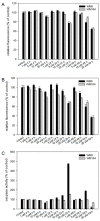Synthesis and Pharmacological In Vitro Investigations of Novel Shikonin Derivatives with a Special Focus on Cyclopropane Bearing Derivatives
- PMID: 33803437
- PMCID: PMC7967198
- DOI: 10.3390/ijms22052774
Synthesis and Pharmacological In Vitro Investigations of Novel Shikonin Derivatives with a Special Focus on Cyclopropane Bearing Derivatives
Abstract
Melanoma is the deadliest form of skin cancer and accounts for about three quarters of all skin cancer deaths. Especially at an advanced stage, its treatment is challenging, and survival rates are very low. In previous studies, we showed that the constituents of the roots of Onosma paniculata as well as a synthetic derivative of the most active constituent showed promising results in metastatic melanoma cell lines. In the current study, we address the question whether we can generate further derivatives with optimized activity by synthesis. Therefore, we prepared 31, mainly novel shikonin derivatives and screened them in different melanoma cell lines (WM9, WM164, and MUG-Mel2 cells) using the XTT viability assay. We identified (R)-1-(1,4-dihydro-5,8-dihydroxy-1,4-dioxonaphthalen-2-yl)-4-methylpent-3-enyl 2-cyclopropyl-2-oxoacetate as a novel derivative with even higher activity. Furthermore, pharmacological investigations including the ApoToxGloTM Triplex assay, LDH assay, and cell cycle measurements revealed that this compound induced apoptosis and reduced cells in the G1 phase accompanied by an increase of cells in the G2/M phase. Moreover, it showed hardly any effects on the cell membrane integrity. However, it also exhibited cytotoxicity against non-tumorigenic cells. Nevertheless, in summary, we could show that shikonin derivatives might be promising drug leads in the treatment of melanoma.
Keywords: apoptosis; cell cycle; melanoma; shikonin derivatives; synthesis.
Conflict of interest statement
The authors declare no conflict of interest.
Figures








Similar articles
-
SK119, a Novel Shikonin Derivative, Leads to Apoptosis in Melanoma Cell Lines and Exhibits Synergistic Effects with Vemurafenib and Cobimetinib.Int J Mol Sci. 2022 May 19;23(10):5684. doi: 10.3390/ijms23105684. Int J Mol Sci. 2022. PMID: 35628494 Free PMC article.
-
Synthesis of Novel Shikonin Derivatives and Pharmacological Effects of Cyclopropylacetylshikonin on Melanoma Cells.Molecules. 2018 Oct 30;23(11):2820. doi: 10.3390/molecules23112820. Molecules. 2018. PMID: 30380765 Free PMC article.
-
Design, synthesis and biological evaluation of cinnamic acyl shikonin derivatives.Chem Biol Drug Des. 2013 Feb;81(2):275-83. doi: 10.1111/cbdd.12077. Epub 2012 Nov 26. Chem Biol Drug Des. 2013. PMID: 23066914
-
An overview of cyclopropenone derivatives as promising bioactive molecules.Bioorg Med Chem Lett. 2024 Sep 1;109:129845. doi: 10.1016/j.bmcl.2024.129845. Epub 2024 Jun 7. Bioorg Med Chem Lett. 2024. PMID: 38852789 Review.
-
Synthesis, biological function and evaluation of Shikonin in cancer therapy.Fitoterapia. 2019 Apr;134:329-339. doi: 10.1016/j.fitote.2019.03.005. Epub 2019 Mar 8. Fitoterapia. 2019. PMID: 30858045 Review.
Cited by
-
SK119, a Novel Shikonin Derivative, Leads to Apoptosis in Melanoma Cell Lines and Exhibits Synergistic Effects with Vemurafenib and Cobimetinib.Int J Mol Sci. 2022 May 19;23(10):5684. doi: 10.3390/ijms23105684. Int J Mol Sci. 2022. PMID: 35628494 Free PMC article.
-
The Biological Assessment of Shikonin and β,β-dimethylacrylshikonin Using a Cellular Myxofibrosarcoma Tumor Heterogeneity Model.Int J Mol Sci. 2023 Nov 2;24(21):15910. doi: 10.3390/ijms242115910. Int J Mol Sci. 2023. PMID: 37958891 Free PMC article.
-
Pharmacological Effects of Shikonin and Its Potential in Skin Repair: A Review.Molecules. 2023 Dec 5;28(24):7950. doi: 10.3390/molecules28247950. Molecules. 2023. PMID: 38138440 Free PMC article. Review.
-
Shikonin Derivatives Inhibit Inflammation Processes and Modulate MAPK Signaling in Human Healthy and Osteoarthritis Chondrocytes.Int J Mol Sci. 2022 Mar 21;23(6):3396. doi: 10.3390/ijms23063396. Int J Mol Sci. 2022. PMID: 35328817 Free PMC article.
-
Review of Shikonin and Derivatives: Isolation, Chemistry, Biosynthesis, Pharmacology and Toxicology.Front Pharmacol. 2022 Jul 1;13:905755. doi: 10.3389/fphar.2022.905755. eCollection 2022. Front Pharmacol. 2022. PMID: 35847041 Free PMC article. Review.
References
-
- Gershenwald J.E., Scolyer R.A., Hess K.R., Sondak V.K., Long G.V., Ross M.I., Lazar A.J., Faries M.B., Kirkwood J.M., McArthur G.A., et al. Melanoma staging: Evidence-based changes in the American Joint Committee on Cancer eighth edition cancer staging manual. CA Cancer J. Clin. 2017;67:472–492. doi: 10.3322/caac.21409. - DOI - PMC - PubMed
MeSH terms
Substances
Grants and funding
LinkOut - more resources
Full Text Sources
Other Literature Sources
Medical

